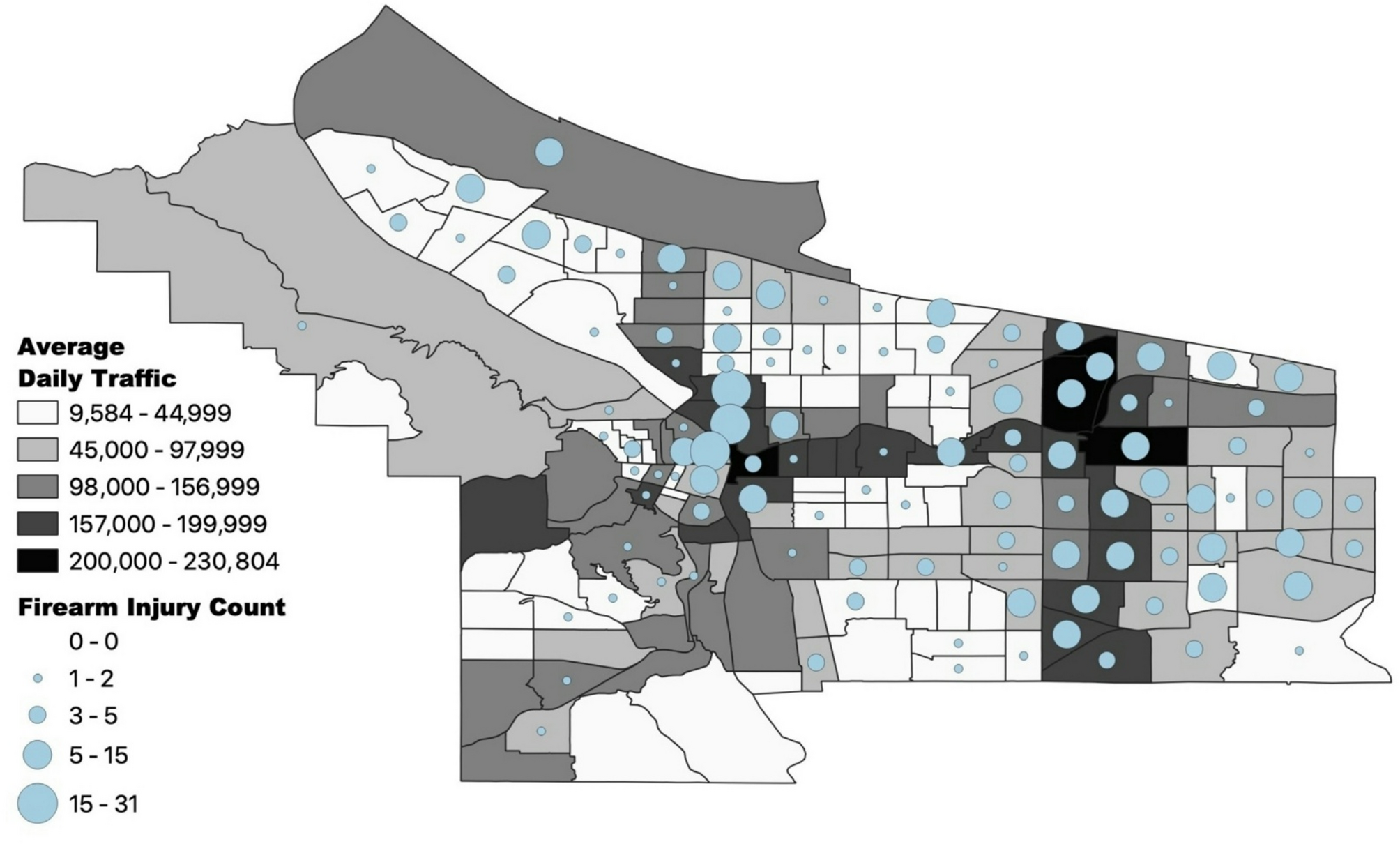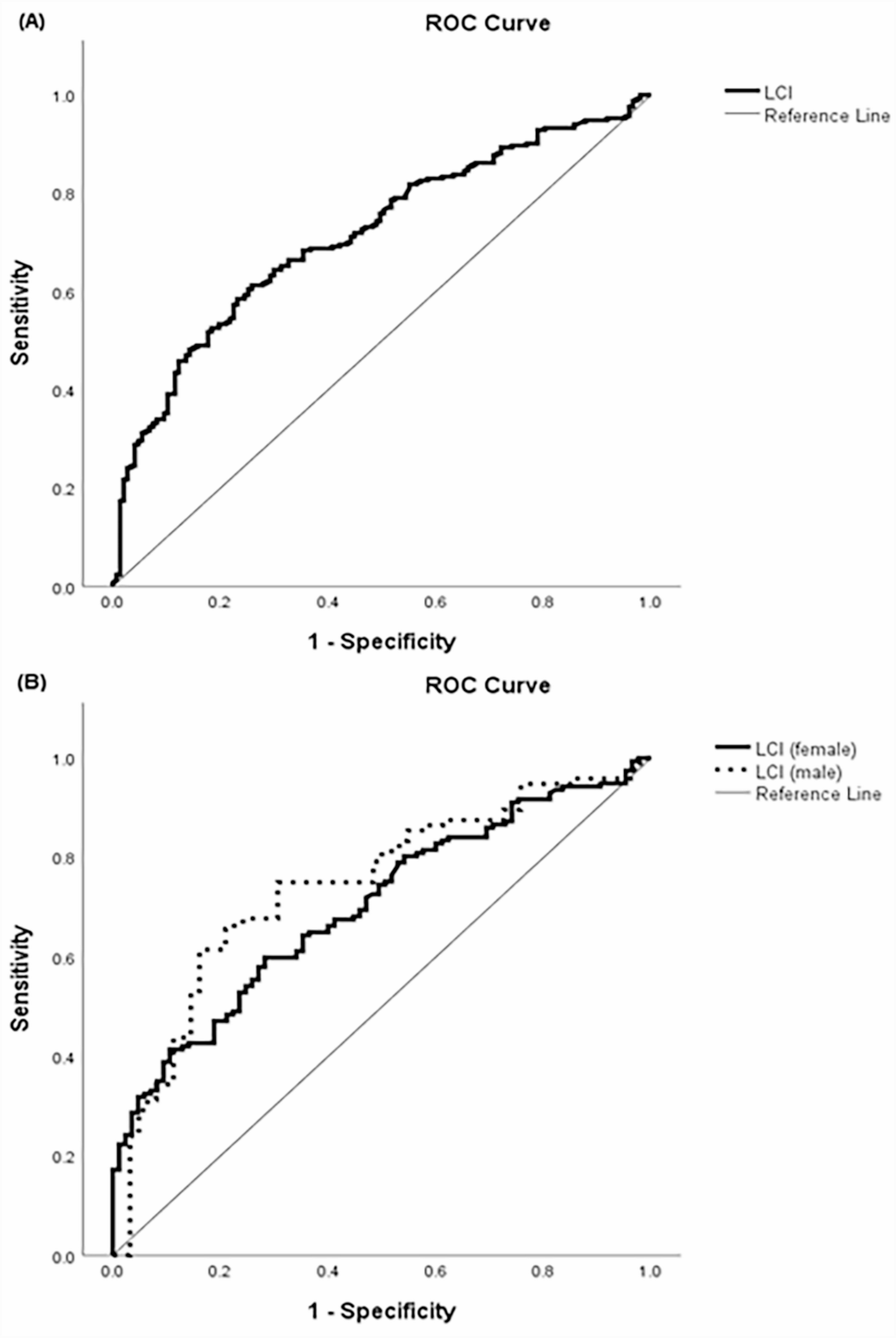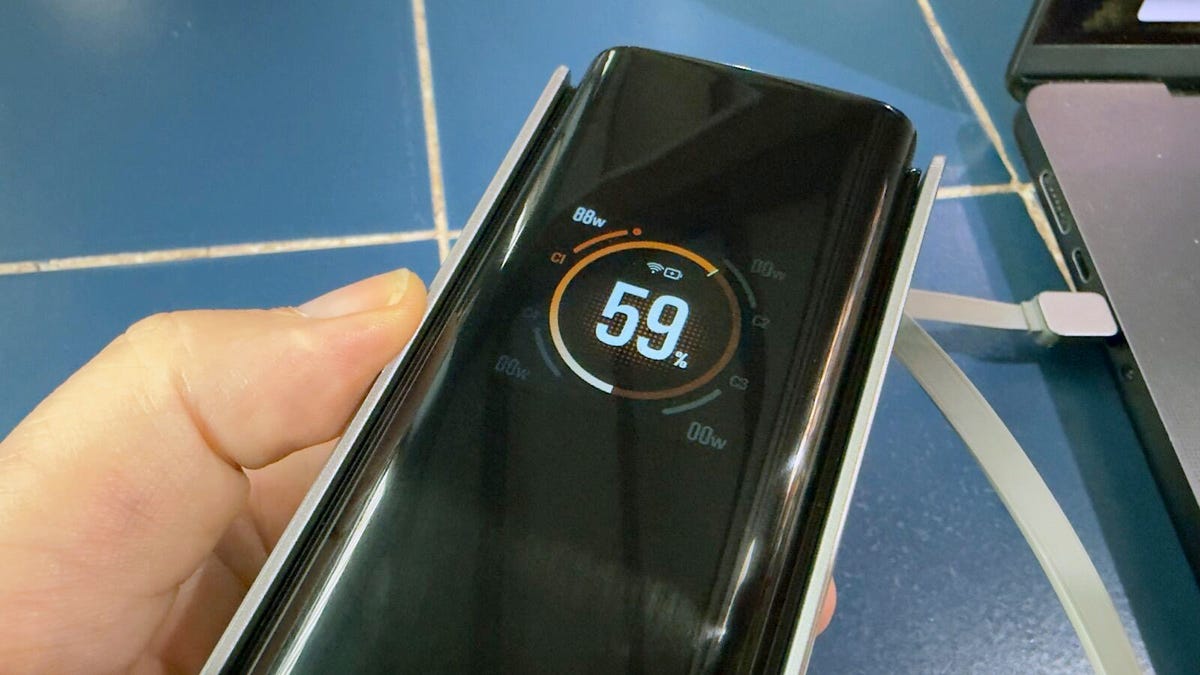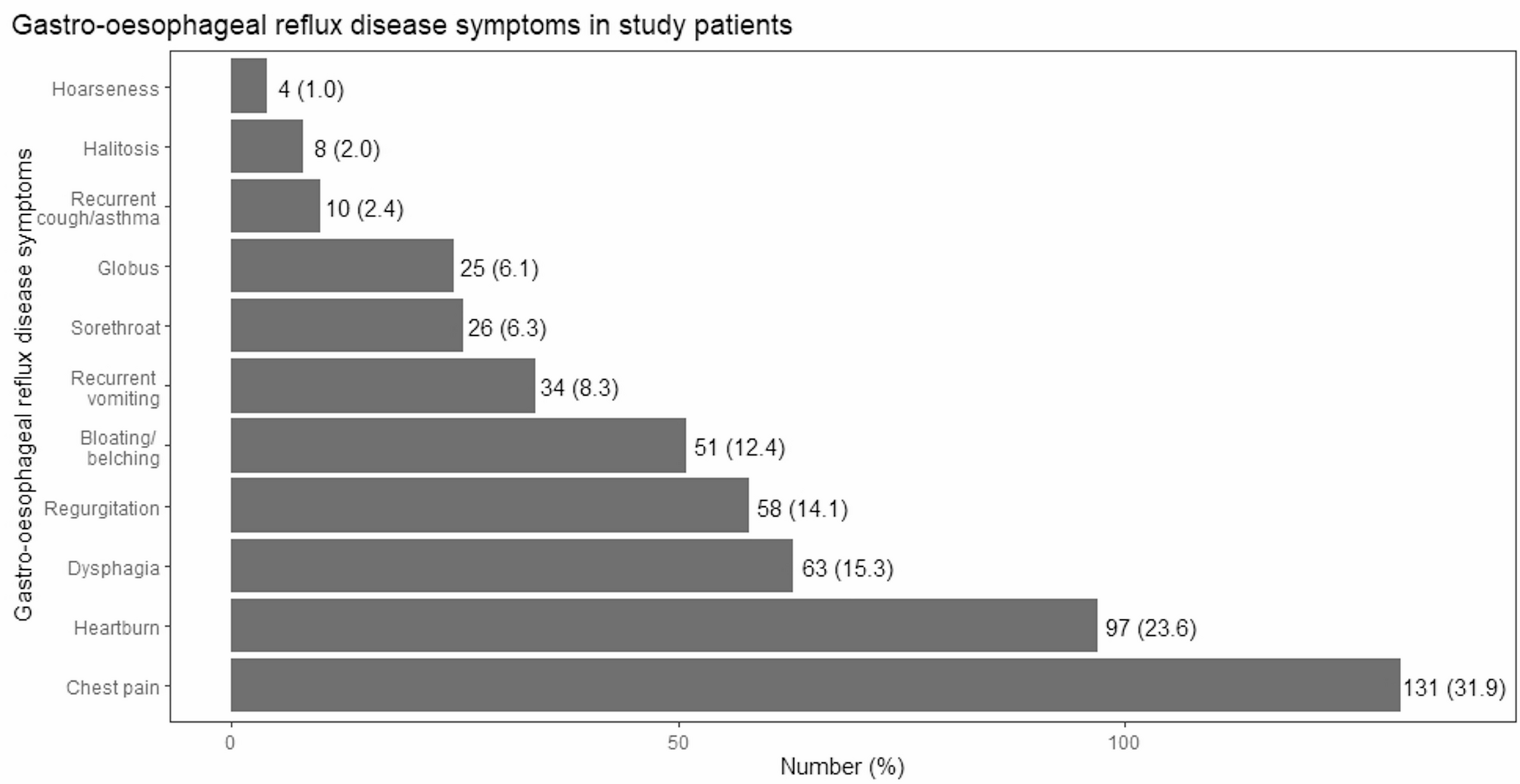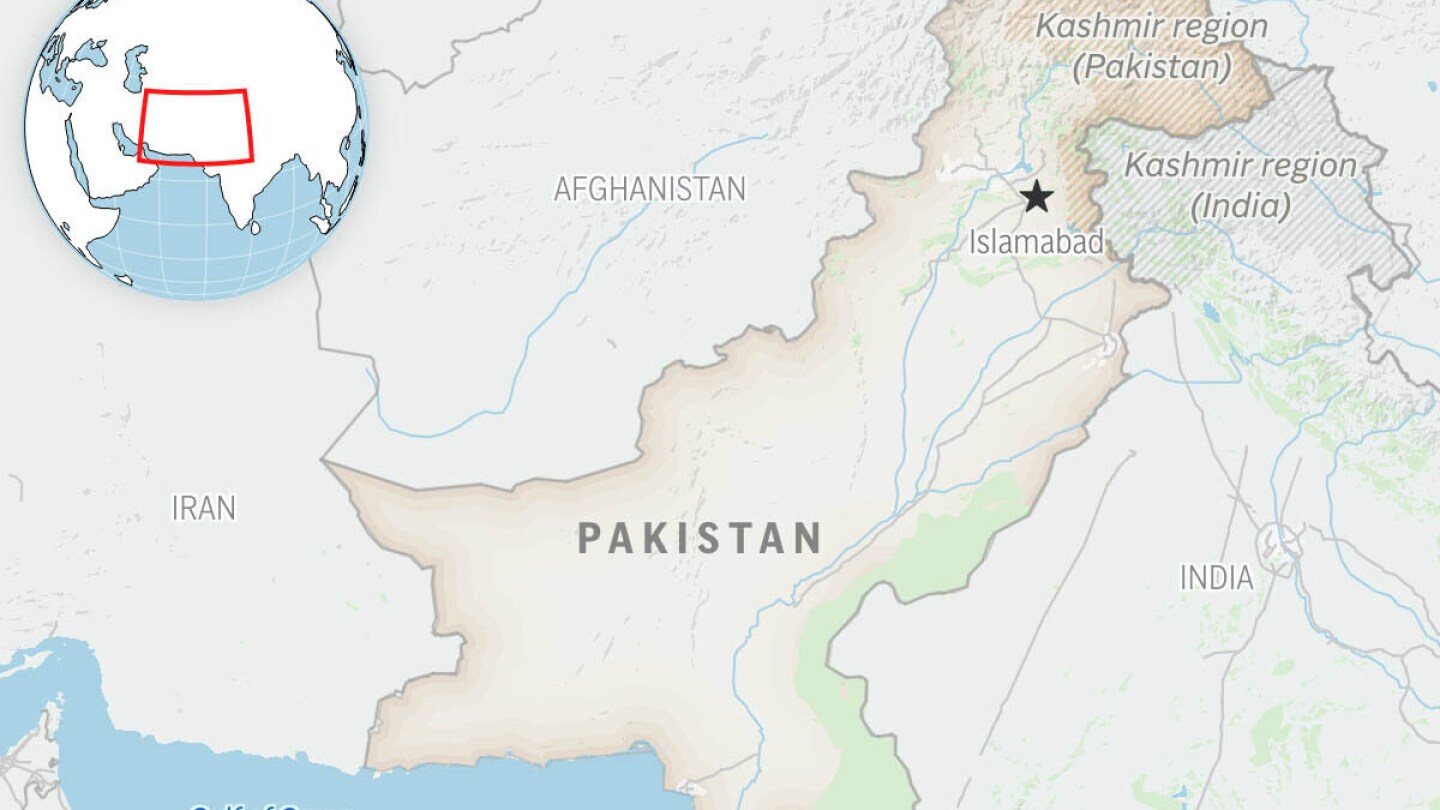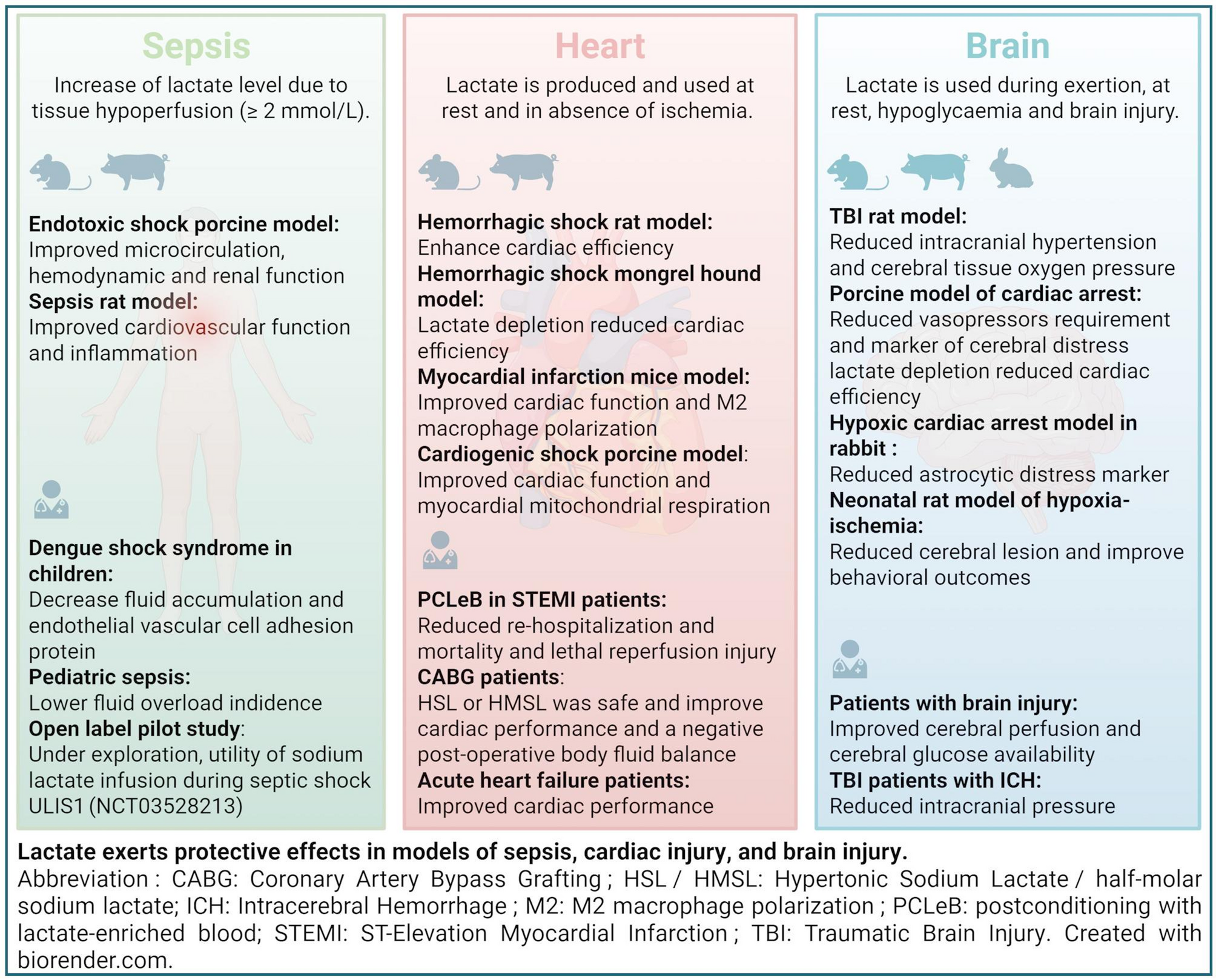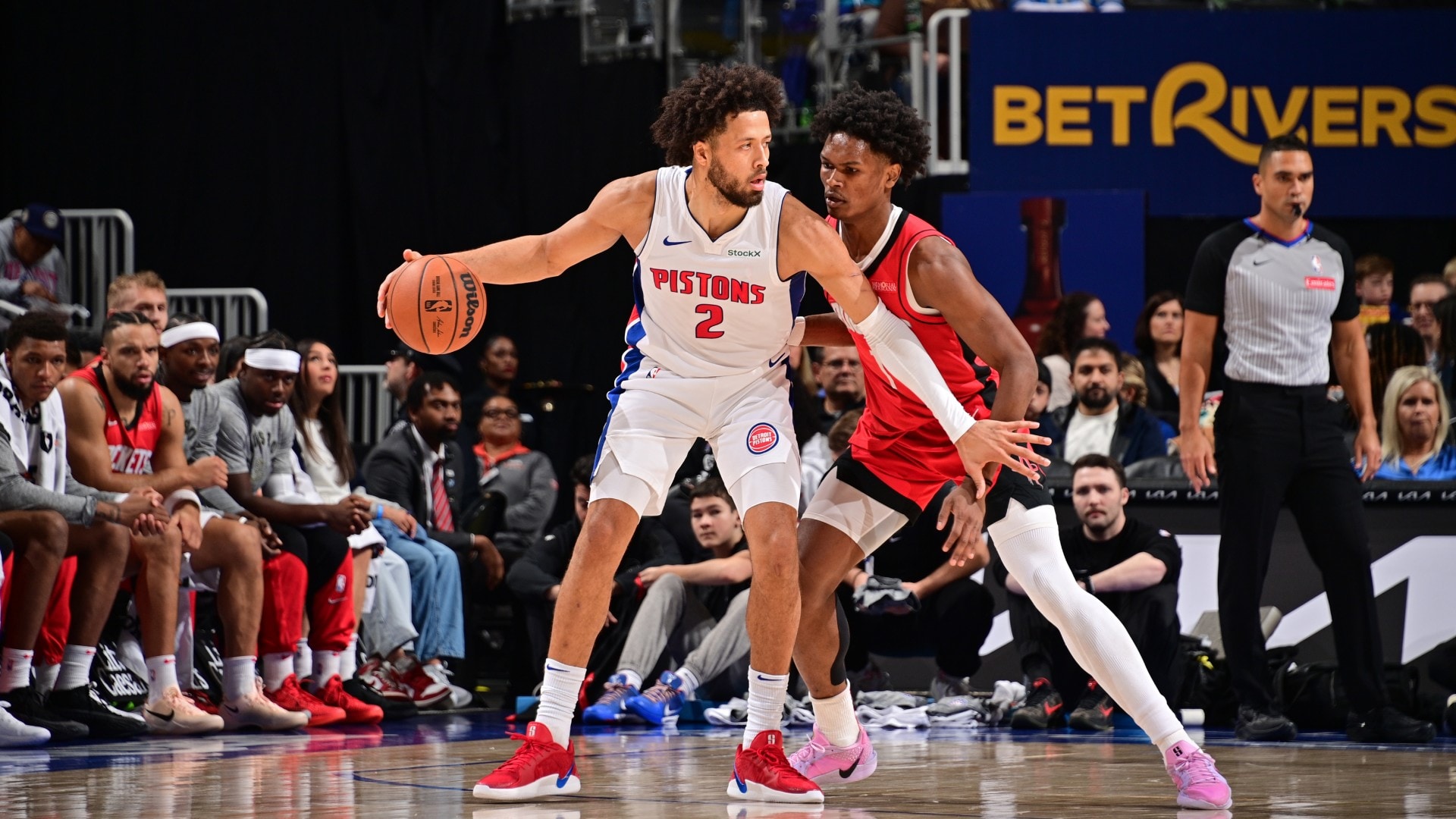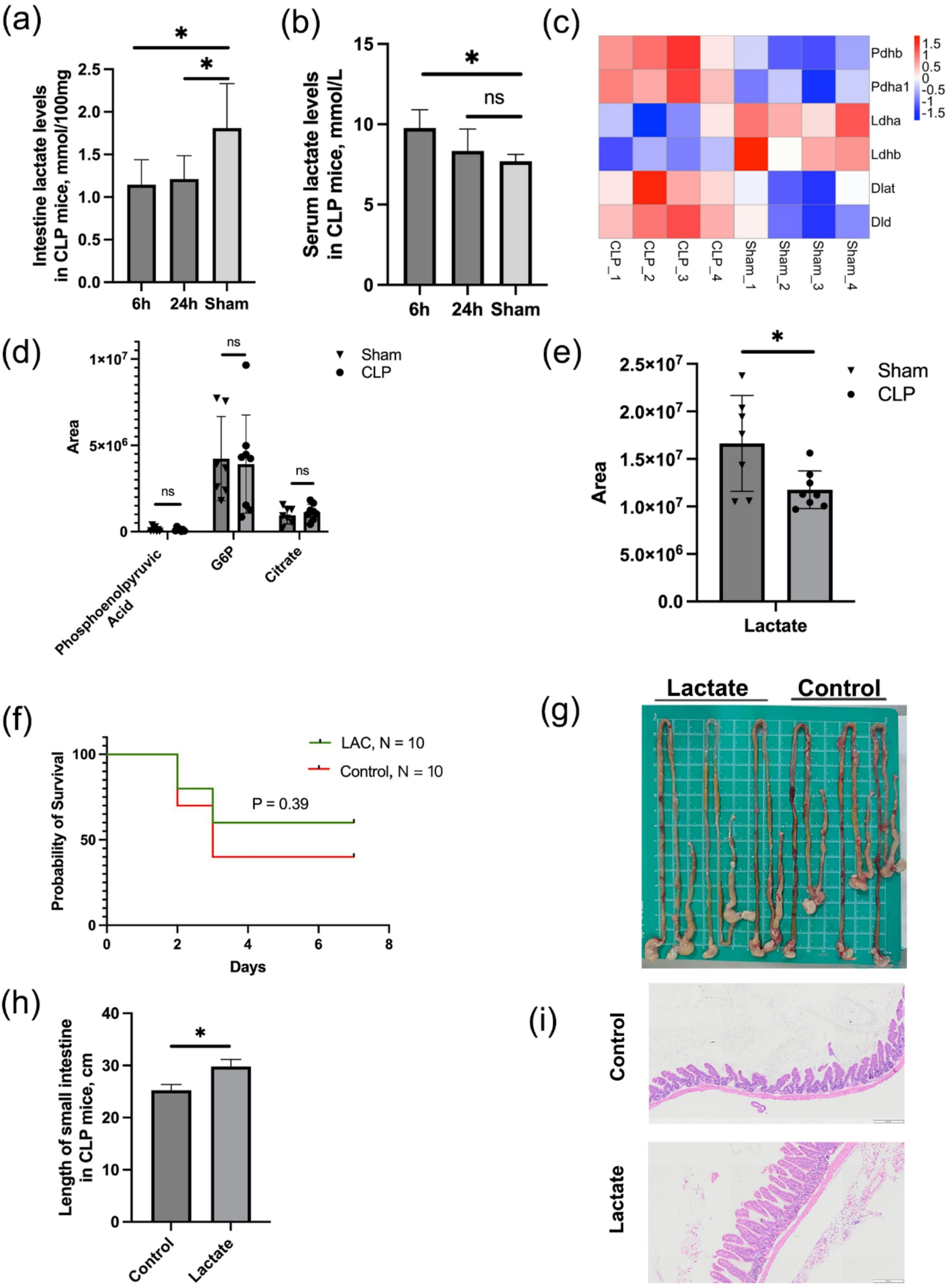In this investigation into vehicle traffic volumes and firearm injury risk, we found that there was a statistically significant relationship between higher vehicle traffic and higher injury counts across the City of Portland; tracts with 10,000 higher vehicle trips exhibited a 27%−29% higher risk of firearm injury occurrence. We also found 1 standard deviation higher traffic volumes to be associated with 59%−85% higher odds of a firearm injury in injury months compared to control periods at the same type and time of day in adjacent months. These spatial and temporal associations, which we identified at the tract-level, were not correspondingly demonstrated when we zoomed in on individual street segments in a single neighborhood of East Portland, finding imprecise associations in the hypothesized direction but of smaller magnitude or insignificant.
Our findings suggest that vehicle traffic volume could play an important role in community firearm violence. To our knowledge, ours is the first study to test this association. However, the finding is consistent with several theoretically plausible mechanisms by which a decrease in vehicular traffic leads to a decrease in community firearm violence. High vehicle traffic discourages foot traffic [23], and instead creates opportunities for people to cross paths (motivated offenders and suitable targets of the Routine Activities Theory), but not to build social bonds or allow nearby residents to monitor who comes and goes or exercise informal social control (lack of a credible guardian). Heavy vehicle traffic may itself be an sign of physical disinvestment, as high-density traffic areas have been shown to disproportionately affect disadvantaged areas in Southern California [44]. In fact, many highway construction projects in the midcentury intentionally bisected or segregated minority neighborhoods serving as a physical, social, and oftentimes economic barrier between adjacent communities [45]. Such neighborhoods that have experienced racialized disinvestment like “white flight,” often have, for example, a lack of sidewalks, and are “driven through” rather than “driven to.” These areas lack the pedestrian-friendly infrastructure to help foster the safety of safe and walkable “busy streets.” East Portland is an example of such an area [30].
Vehicle traffic is also inherently linked to other forms of social and economic disinvestment which help drive disparities in firearm injury risk by race and income. In East Portland, such disinvestment has led to an under-resourced and highly segregated urban environment dominated by vehicle traffic. Following recent gentrification of North and Northeast Portland, which saw a decrease in the percentage of Black residents over time, the population of East Portland grew substantially and saw an increase in Black residents over the same period. With this displacement, members of previously spatially separated gangs have now found themselves living interspersed thus increasing contact and exacerbating existing feuds. Racialized segregation and disinvestment are often compounded by a lack of inclusionary zoning laws, which benefit low-income and disadvantaged communities. Oregon overturned its ban on inclusionary zoning in 2016 [46], the last state besides Texas to do so, though Portland’s inclusionary zoning mandate has only recently been gaining traction [47]. Future investment in inclusionary zoning may help address some issues of concentrated disinvestment, but the historic legacy of exclusionary built environment practices have exacerbated existing challenges in interrupting community violence.
Place-based violence prevention initiatives have been found to be effective and affordable interventions to reduce gun violence in East Coast cities but may not be as effective in post-industrial cities with fewer vacant or neglected urban plots. For example, previous analyses have found larger associations between place-based interventions and crime reductions, including violent crime, in East Coast cities compared to results found from New Orleans, a city with a distinctly different built and natural environment [48]. In an urban environment such as Portland, OR where there are few vacant lots, and particularly East Portland where the average age of buildings is much newer than the originally developed city center, focusing on how people move through the physical space may be a more promising approach to reducing firearm injuries. Traffic control interventions that reduce trips on non-arterial roads through diversion or local road closure, as well as traffic calming mechanisms such as speed bumps, sidewalk bulbs (curb outs), and road diets that promote other forms of active transport are all worthwhile interventions to explore. All of these interventions are meant to direct non-resident drivers to arterials intended for drive-through traffic, or to slow or impede drivers in residential areas to reduce heedlessness and promote the safety of nearby pedestrians and residents.
There may be several reasons as to why this relationship between vehicle traffic and firearm injuries was shown at the tract-level but not significantly along individual street segments. The first may be that the street segment analysis was underpowered due to small numbers – in fact, many of the analyses showed attenuated results that were positive but imprecise and not statistically significant. However, it may also be an early indication that the potential pathway through which vehicular traffic may increase risk of a firearm shooting is most relevant at the neighborhood context as opposed to on each individual street. For example, in areas with high vehicle volume streets – areas where many people including likely non-residents are driving through as opposed to driving to – the elevated vehicle traffic may create environments that result in higher firearm injury risk not on the major roadways themselves but rather on adjacent streets within the network (i.e. proximity to a higher trafficked roadway as opposed to location on a higher trafficked roadway leads to higher risk for nearby residents). The feeling of anonymity this creates could translate to a lack of guardianship, and lack of social control. It is also possible that areas built for cars rather than people share other risk factors that contribute to firearm injury risk separate from traffic. Future research should consider the appropriate geographical context for intervening on traffic-related firearm injury risk and begin to tease apart the causal mechanisms through which traffic may be contributing to firearm injury risk.
Limitations
Our traffic exposure was a modeled estimate as opposed to real vehicle counts. However, actual traffic counts are difficult and labor-intensive to collect; often traditional traffic count data come from traffic counters set up on certain major roads only on specific days. Additionally, traffic counts are typically collected during morning commutes, when violence incidence is lowest, limiting our ability to investigate any association between traffic and firearm shootings. The type of fine temporal and spatial traffic estimates necessary to address our research question do not exist. Thus, our use of the street-level modeled traffic data made it possible to investigate associations between vehicle traffic and community firearm violence, which would not have been possible at this scale using traditional data. However, modeled data often smooths true outliers as models are most capable to modeling averages. As such, we were unable to measure fine scale changes over time.
Secondly, our study bisected the COVID-19 pandemic period – a time defined by dramatic and swift mobility changes as well as increases in firearm injuries both in Portland, OR and in many other communities across the United States [49]. While understanding how risky relationships were altered during this period is an enormous and complex challenge, it was within this same period that local residents in East Portland raised their concern about increases in vehicle traffic and firearm violence in their communities. This community-academic partnership arose as a result of that community input, and thus the theory behind our research question was grounded in community concerns. Additionally, results of a sensitivity analysis stratifying the tract-level cross-sectional analysis by the pre-Covid and Covid periods did not show heterogeneous estimates (results available upon request).
Lastly, this work was intended to address a novel research question with a broad and multi-faceted analysis approach. Our intent was to first gain insight into whether there was a relationship between vehicle traffic and firearm injury and provide some groundwork for hypothesis generating results. These are not causal estimates. It is important to highlight the possibility of reverse causation here, where a firearm injury could potentially lead to greater vehicle traffic if the incident caused nearby residents to feel uncomfortable walking, or less traffic if drivers chose to avoid an area they deemed risky. We attempted to assess the temporality of the association in the case-crossover models stratified into the pre and post comparison months, but we were not able to explore the specific mechanistic pathways through which vehicle traffic may be impacting firearm injury risk using these monthly data. Additionally, we did not have data specifically on road rage incidents and thus were unable to examine differences in roadway vs. nearby community firearm assaults. This intelligence will be crucial to understanding how to intervene going forward. Future research should explore potential effect modification in vehicle traffic risk by other potential risk or protective factors such as neighborhood SES, urban zoning, or pedestrian safety infrastructure in order to start teasing apart mechanistic pathways that can be leveraged for intervention.
Implications
Innovative strategies to curb firearm violence are necessary today more than ever with changes being seen in firearm assault etiology, such as spatial deconcentrating of injury occurrences [50], and the influence of social media altering how social networks interact in physical and digital space. Within the far-reaching landscape of firearm injury mortality and morbidity, this study suggests that traffic restriction or modification may be one avenue to reduce community firearm violence, and as such, warrants further study.
Distribution of daily traffic volume within Portland census tracts by time of day and day type, 2019–2021. Streetlight, Inc traffic estimates stratified by day type classify weekends as Saturday and Sunday, and weekdays as Monday through Thursday
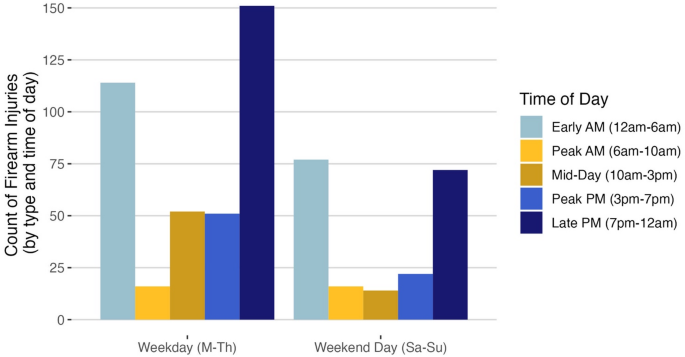
Count of firearm injuries within Portland by time of day and day type, 2019–2021
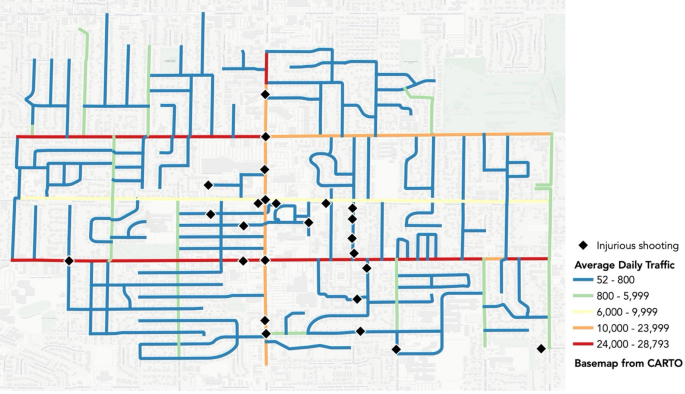
Steet segment average daily traffic and firearm shootings within the Hazelwood corridor, 2019–2021
